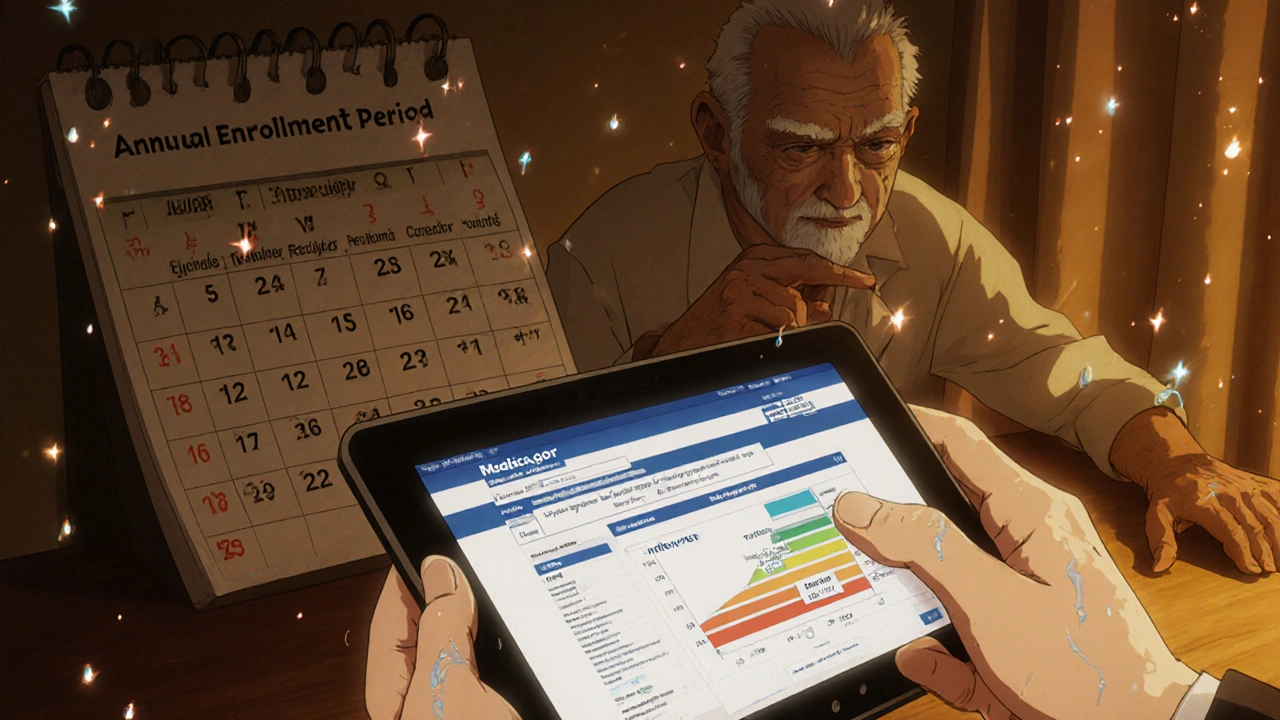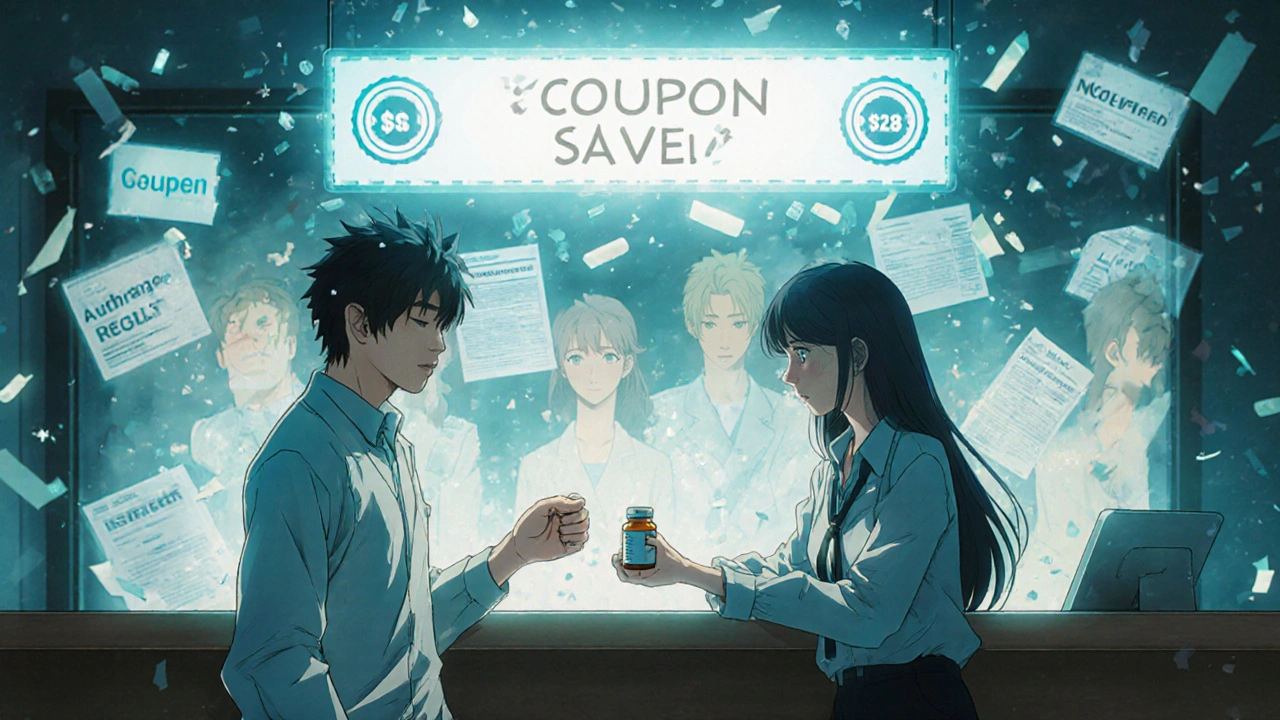Walking into the pharmacy with a new prescription only to be hit with a $300 bill is more common than you think. In fact, 22% of people in the U.S. skip filling prescriptions because they can’t afford them, according to 2023 GoodRx data. That’s not just bad luck-it’s a system failure. But here’s the good news: you don’t have to accept that. Talking about cost before you leave your doctor’s office can save you hundreds-or even thousands-of dollars a year.
Why Waiting Until the Pharmacy Is a Mistake
Most people assume their insurance will cover their meds. They trust the doctor. They trust the pharmacy. But insurance plans are complicated. Formularies change. Deductibles reset. And if you don’t check, you’re gambling with your health and your wallet.Take insulin, for example. Under the Inflation Reduction Act, Medicare beneficiaries now pay no more than $35 per month for covered insulin. But if you’re on a commercial plan and didn’t ask, you might still be paying $100, $200, or more. Same goes for blood pressure meds, diabetes drugs, or antidepressants. A 2022 study in the Journal of General Internal Medicine found that patients who talked about cost with their provider were 37% less likely to skip doses because of price.
That’s not a small difference. It’s life-changing.
What You Need to Know Before Your Appointment
You don’t need to be a healthcare expert to have this conversation. You just need to be prepared. Here’s what to gather before you see your doctor:- Your insurance card (or the name of your plan)
- Your current deductible status (check your insurer’s website or call customer service)
- A list of the meds you’re currently taking, including dosages
- Any known allergies or past reactions to medications
- Questions about generics, mail-order options, or patient assistance programs
If you’re on Medicare, log into Medicare.gov and use the Plan Finder tool. It lets you compare costs for your exact prescriptions across all Part D plans in your area. You can do this any time, but it’s especially useful during Annual Enrollment Period (October 15-December 7), when plans update for the next year.
For commercial insurance, check your insurer’s website. Most have a “Drug Cost Checker” or “Formulary Lookup.” CVS Caremark, Humana, and UnitedHealthcare all offer these tools. Just type in the drug name and see what tier it’s on-and what your copay will be.
What to Say to Your Doctor
You don’t have to be shy. Doctors expect this. The American Medical Association has recommended cost discussions since 2018. Here’s how to bring it up naturally:- “I’m concerned about the cost of this medication. Do you have any lower-cost alternatives?”
- “Is there a generic version available?”
- “Will this be covered under my plan, or will I hit my deductible?”
- “Can I get a 90-day supply to lower my out-of-pocket cost?”
- “Are there any patient assistance programs or coupons I can use?”
Don’t be afraid to say, “I can’t afford this.” That phrase alone opens the door to real solutions. Many doctors keep samples on hand. Others can switch you to a similar drug that’s cheaper or on formulary. One patient in Bristol told me she avoided a $1,200 monthly bill by asking her doctor about a different statin-her new prescription cost $12 a month instead.
How Insurance Tiers Work (And Why They Matter)
Most insurance plans use a tier system to control costs. The higher the tier, the more you pay. Here’s how it typically breaks down:| Tier | Drug Type | Average Copay (2025) |
|---|---|---|
| Tier 1 | Generic drugs | $5-$15 |
| Tier 2 | Preferred brand-name drugs | $25-$50 |
| Tier 3 | Non-preferred brand-name drugs | $50-$100 |
| Tier 4 | Specialty drugs | 25-33% coinsurance (often $100+ per fill) |
Specialty drugs-like those for rheumatoid arthritis, MS, or cancer-are the most expensive. They often require prior authorization, meaning your doctor has to prove medical necessity before your plan will pay. That can take days or weeks. If you wait until the pharmacy to find out, you might be stuck without your medicine.

Medicare vs. Commercial Insurance: Key Differences
If you’re on Medicare Part D, you’re getting stronger protections than most commercial plans:- Out-of-pocket cap: Starting in 2025, Medicare beneficiaries pay no more than $2,000 per year for prescriptions. Before 2025, the cap was $8,000.
- Insulin cap: $35/month for all covered insulins.
- Monthly payment plan: The new Medicare Prescription Payment Plan lets you pay for drugs in installments instead of one big bill at the pharmacy.
Commercial plans? No federal cap. No insulin limit. Some plans charge $500 or more for a single specialty drug. And if you’re on a bronze plan, your deductible might be $500 or higher-meaning you pay 100% until you hit that number.
Medicaid, on the other hand, usually has the lowest copays-often $1 to $3-but may require prior authorization for many drugs. It’s not always easier, just cheaper upfront.
Tools That Actually Save Money
You don’t have to guess. Use these free tools:- GoodRx: Compares prices at local pharmacies and offers printable coupons. One user saved $287 on blood pressure meds by showing the pharmacist a GoodRx price-even with insurance.
- SingleCare: Similar to GoodRx, often with different discounts.
- RxSaver: Another free coupon app with competitive pricing.
- Real-Time Prescription Benefit (RTPB): If your doctor uses an electronic health record system (most do), they can see your exact out-of-pocket cost right in their system. Ask them to check it before writing the script.
Pro tip: Always compare the pharmacy price with your insurance copay. Sometimes, paying cash with a GoodRx coupon is cheaper than using insurance.
When to Call Your Insurance Company
If you’re unsure, call them. Have your drug’s NDC number (it’s on the label), your member ID, and your date of birth ready. Ask:- “Is this drug on my plan’s formulary?”
- “What’s my copay for this drug at a retail pharmacy?”
- “Is there a generic or preferred alternative?”
- “Do I need prior authorization?”
- “Can I get a 90-day supply?”
Wait times can be long-14.7 minutes on average in 2023-but it’s worth it. One woman in Bristol called her insurer before filling a new diabetes drug and found out it wasn’t covered. She asked her doctor for a different one, saved $180 a month, and avoided a month-long delay.

What If Your Drug Isn’t Covered?
Don’t panic. There are still options:- Prior authorization: Your doctor can submit paperwork to get your drug approved. This works in 68% of cases where the drug is medically necessary.
- Appeal: If denied, you can appeal. Most plans have a clear process.
- Manufacturer assistance: Many drugmakers offer free or low-cost programs for low-income patients. Check their websites or call their patient support lines.
- Nonprofit help: Organizations like the Patient Advocate Foundation and NeedyMeds can connect you to aid.
According to the Patient Advocate Foundation, 43% of prescription cost issues are because a drug isn’t on the formulary. But 68% of those cases get resolved with provider help.
Timing Matters: When to Ask
The best time to talk about cost is before the prescription is written. Once it’s printed, it’s harder to change. Don’t wait until the last minute.Also, watch the calendar. If you’re on a deductible plan, January through March is the most expensive time. You haven’t met your deductible yet. Later in the year, you might pay less because you’ve already paid your share. If you can delay non-urgent prescriptions until after your deductible is met, you’ll save money.
Final Tip: Always Double-Check at the Pharmacy
Even after all this, always ask the pharmacist: “What’s my total out-of-pocket cost today?” They have access to real-time pricing. Sometimes, a coupon or a switch to a different generic makes a huge difference.And if you’re still shocked by the price, ask: “Is there a cheaper way to get this?” Many pharmacists know about manufacturer coupons, mail-order options, or discount programs. Don’t just pay and walk away. You have power here.
What if my insurance says my drug is covered, but the pharmacy says it’s not?
This happens more often than you’d think. Insurance plans update formularies frequently, and pharmacy systems don’t always sync right away. Call your insurer’s customer service with your NDC number and ask for a written confirmation. Then take that info back to your doctor and pharmacy. You may need a prior authorization or a different drug.
Can I use GoodRx and my insurance together?
No. You have to choose one or the other. Sometimes, GoodRx is cheaper than your insurance copay. Other times, insurance wins. Always compare both prices at the pharmacy counter before you pay.
Are generic drugs as effective as brand-name ones?
Yes. The FDA requires generics to have the same active ingredient, strength, dosage form, and route of administration as the brand-name drug. They’re tested to be equally effective and safe. The only differences are inactive ingredients (like fillers) and cost-generics are often 80-85% cheaper.
Why do some drugs cost so much more than others?
It’s not always about how the drug works. Pricing is driven by patents, market competition, and corporate strategy. New drugs without generics can cost hundreds or thousands because there’s no competition. Once generics enter the market, prices drop dramatically. That’s why asking for a generic-or switching to one-can save you so much.
What if I can’t afford my meds even after all this?
You’re not alone. Start with NeedyMeds.org or the Patient Advocate Foundation. They help people find free or low-cost meds, financial aid, and payment plans. Some drug manufacturers offer patient assistance programs if your income is below a certain level. Don’t stop asking. There’s help available.
Prescription costs shouldn’t be a surprise. They shouldn’t force you to choose between your health and your rent. Talking about money before you fill that script isn’t rude-it’s smart. And it’s your right.



Kaylee Crosby
November 25 2025Just last month I asked my doc about my antidepressant cost and she switched me to a generic that saved me $180 a month. Seriously, just say the words 'I can't afford this' and watch the magic happen. You'd be shocked how often they have samples or alternatives. Don't be shy - your health is worth it.
Karen Ryan
November 26 2025THIS. 😭 I skipped my blood pressure med for 3 weeks because I thought insurance would cover it. Turned out it wasn't even on formulary. Now I always check GoodRx before I leave the office. Also, pharmacies will sometimes match coupons if you ask nicely. 💪
Adesokan Ayodeji
November 27 2025Man, I wish I'd known this stuff 5 years ago when I was working two jobs just to afford my insulin. I used to split pills just to make them last. Now I tell every new patient I meet - don't wait until the pharmacy counter to ask about cost. Your doctor isn't judging you, they're there to help. I even started a little group chat with my neighbors where we share GoodRx codes and pharmacy tips. One guy found a $12 version of his statin that saved him $200/month. It's not rocket science, it's just knowing where to look. And yeah, sometimes you gotta call your insurer like 3 times, but trust me, it's worth it. I used to think asking about money was rude. Turns out, the rude thing is letting them charge you $400 for a pill that should cost $15. You're not being difficult - you're being smart. And if you're on Medicare, holy cow, use that $35 insulin cap. It's there for a reason. Don't let pride cost you your health.